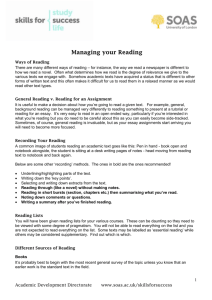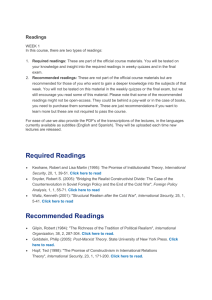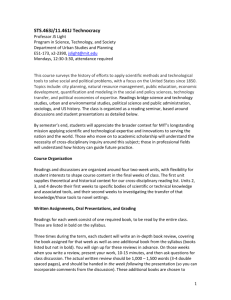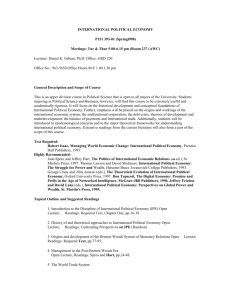Modern Art 109
advertisement
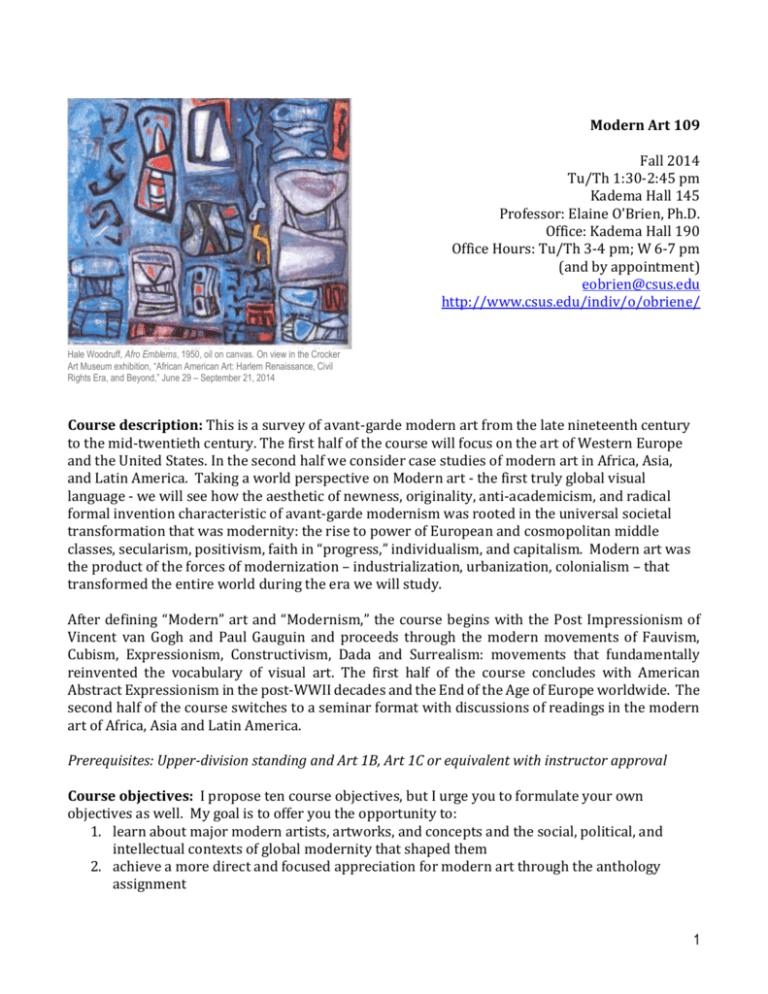
Modern Art 109 Fall 2014 Tu/Th 1:30-2:45 pm Kadema Hall 145 Professor: Elaine O'Brien, Ph.D. Office: Kadema Hall 190 Office Hours: Tu/Th 3-4 pm; W 6-7 pm (and by appointment) eobrien@csus.edu http://www.csus.edu/indiv/o/obriene/ Hale Woodruff, Afro Emblems, 1950, oil on canvas. On view in the Crocker Art Museum exhibition, “African American Art: Harlem Renaissance, Civil Rights Era, and Beyond,” June 29 – September 21, 2014 Course description: This is a survey of avant-garde modern art from the late nineteenth century to the mid-twentieth century. The first half of the course will focus on the art of Western Europe and the United States. In the second half we consider case studies of modern art in Africa, Asia, and Latin America. Taking a world perspective on Modern art - the first truly global visual language - we will see how the aesthetic of newness, originality, anti-academicism, and radical formal invention characteristic of avant-garde modernism was rooted in the universal societal transformation that was modernity: the rise to power of European and cosmopolitan middle classes, secularism, positivism, faith in “progress,” individualism, and capitalism. Modern art was the product of the forces of modernization – industrialization, urbanization, colonialism – that transformed the entire world during the era we will study. After defining “Modern” art and “Modernism,” the course begins with the Post Impressionism of Vincent van Gogh and Paul Gauguin and proceeds through the modern movements of Fauvism, Cubism, Expressionism, Constructivism, Dada and Surrealism: movements that fundamentally reinvented the vocabulary of visual art. The first half of the course concludes with American Abstract Expressionism in the post-WWII decades and the End of the Age of Europe worldwide. The second half of the course switches to a seminar format with discussions of readings in the modern art of Africa, Asia and Latin America. Prerequisites: Upper-division standing and Art 1B, Art 1C or equivalent with instructor approval Course objectives: I propose ten course objectives, but I urge you to formulate your own objectives as well. My goal is to offer you the opportunity to: 1. learn about major modern artists, artworks, and concepts and the social, political, and intellectual contexts of global modernity that shaped them 2. achieve a more direct and focused appreciation for modern art through the anthology assignment 1 3. 4. 5. 6. advance your visual literacy and vocabulary learn how to discern relevant (and irrelevant) episodes in artist biographies gain insight into artists’ intentions for their artwork from reading their own writings master the meaning of critical terms, beginning with “modern,” “modernism,” “modernity,” “modernist,” “avant-garde,” and “academic” 7. become aware of why and how modern art and modernism were so radically different from what came before and why key modernist values have fallen into disrepute today 8. come to an understanding of why there are so few women and non-European artists in the (Western) canon of modern art history 9. be able to see art and life from a historical perspective 10. improve skills in writing, research, critical thinking, collaborative learning and communication To help you achieve these objectives and earn an A in this and other courses see: o Dartmouth College Academic Skills website: http://www.dartmouth.edu/~acskills/success/index.html o Study Guides and Strategies Website http://www.studygs.net/ Take advantage of university student services: o CSUS Writing Center: http://www.csus.edu/writingcenter/ o CSUS Library instruction: You can get personal assistance with research at any time from a reference librarian on the second floor of the library. I will give in-class instruction in database use. Note: Average college courses require a minimum of 9 hours per week of study outside of class (time for reading, writing papers, and test preparation). Click here for standard academic time requirements and management tips. Required Texts: Note: bring the relevant book to class for possible discussions. They are on 2hour reserve in the library. You can photocopy the readings and bring them to class. Herschel Chipp, Theories of Modern Art: A Source Book by Artists and Critics, UC Press, 1984. This is an excellent collection of artists’ writings. Elaine O'Brien et. al., Modern Art in Africa, Asia, and Latin America: An Introduction to Global Modernisms, Wiley-Blackwell, 2013 Readings available on the course website under “Art 109, Readings” Marshall Berman, “Modernity – Yesterday, Today and Tomorrow” (website) Recommended Text: Sylvan Barnet, A Short Guide to Writing about Art (I recommend buying this book as a desk reference, but a PDF can be downloaded for free: http://macaulay.cuny.edu/eportfolios/2011klich902/files/2011/09/Barnet.pdf ) Course Requirements and Grade Basis: 10% Participation: Good participation is how much you help yourself and others learn: a positive, questioning, engaged attitude toward the class. This is evident in attendance, being on 2 time, attentiveness, and note taking. I hope you will meet with me during my office hours or by appointment – the earlier in the semester the better – meeting you helps me teach you better. Note taking: The first part of the course is lecture based. Information presented in lecture contains information and central concepts of the course and your knowledge of it will be on exams. According to cognitive research, we only recall 50% of what we hear and of that, that 20-30% is incorrect. Therefore, taking good notes is crucial for success in college. Participation during small-group discussion: The second part of the course is discussion based. You will be asked to join in small-group discussions where your participation (how much you help others learn) is most evident. o Never leave your discussion group to talk with me individually. [Talk with me after class if it’s a quick question or comment; see me during office hours or email me for an appointment if it’s a more complicated issue.] o Never leave the classroom during small-group discussions. Discussion is as important as lecture, perhaps more important. Attendance policy Two unexcused absences reduce your grade by half a letter grade; three reduce it by one letter grade; each subsequent absence reduces your grade by a whole letter. Five unexcused absences result in automatic failure. Chronic (more than 3 times) lateness or leaving early can reduce your grade by one letter. Illness and family/childcare emergencies are excused. Scheduled appointments, transportation problems, and job demands are not excused. Absence due to illness requires a medical excuse. You can get a medical excuse from the CSUS student health clinic. Inform me of family emergencies or any situation that will keep you from class or affect your ability to learn. Do not hesitate to come to see me during my office hours or make an appointment via email. We can also schedule a phone call. NOTE: Use of cellphones, laptops, any electronic communication device is forbidden because it distracts other students and shows disrespect for the class. Please keep everything turned off and out of sight. Otherwise I will ask you to leave and mark you absent. NOTE: A dark art history room is conducive to napping. Sleeping in class, however, means you aren’t learning and it brings down class morale, including mine. I might wake you up, ask you to leave class, and mark you absent. NOTE: No eating or drinking please. I will ask you to put it away. NOTE: If you have a documented disability and verification from SSWD, and wish to discuss academic accommodations, please contact me as soon as possible. 40% reading response papers, 1-page (250 words) each Important NOTE: Late reading response papers are not accepted except for excused absences. The response papers are often the basis of class discussions and must be on time so you can contribute to the discussion and get more out of the lectures. If you have an excused absence, attach a note to the paper and turn it in for credit. The “RReading” assignments are indicated on the syllabus. 3 For each of the readings in the Chipp anthology, Theories of Modern Art: 1. On top of your paper, write your name, date, name of author or authors, title of the reading(s), and original date of writing or publication. 2. Select three quotations from the beginning, middle, and end of the entire reading (which may include a sequence of short readings) that give the best insights into the work of the artist(s). For each of the three quotations, put the author, page number, the year the document was written, and two or three sentences explaining the insight you got from the quotation. 3. Conclude with a short paragraph about what you learned about Modern art from the reading. For each of the readings in the Global Modernisms anthology: 1. On top of your paper, write your name, date, author’s name, full title of the reading (put quotation marks around the title), and date of publication. 2. Find and quote the author’s thesis statement in the article. Put the page number in parentheses next to the quoted thesis statement. Put the author’s thesis statement in your own words. Each paraphrase should be about equal in length to the quotation. 3. Quote and paraphrase 3 key points the author makes - from the beginning, middle, and end of the reading. A “key point” is not merely interesting; it supports (proves) the credibility of the author’s thesis. A key point is usually a historical fact that the author is using as evidence that his or her claims are true. 4. Conclude with a short paragraph about what you learned about Modern art from the reading. Proving that you comprehend the reading well is the most important objective. If you have trouble understanding the reading, don’t worry. Come see me during my office hours or by appointment. We can also make a telephone appointment. You can email me anytime if you don’t need an immediate response. 10% Midterm Exam: October 23: A one-hour cumulative exam consisting of three identification questions (see format description below) and one essay question drawn from lectures and readings. I will give you the essay question and go over the exam on October 21. Identification question format: Identify 1) full name and nationality of artist, 2) title of artwork, and 3) date within 5 years, 4) medium, and 5) historically significant points about the artwork from lectures, class discussions, and readings. Your grade is based on how much mastery of the material is demonstrated. This includes historical facts (who? what? when? where? why?), and historical contexts learned from lectures, class discussions and readings. Suggestions for how to study for an art history test: Form a study group and/or get a study partner Go to the Art 109 PowerPoint lectures on the course website Make flashcards – one for every artwork that was shown in lecture. 4 1) On the front of the card draw a thumbnail sketch of the artwork with no written information. 2) On the back, write down information you will need to know about that artwork. Note information from readings, videos, and lectures about the work and all related information. 10% Final Exam: Thursday, December 18, 12:45-2:45 pm, Kadema 145. Two hour essay exam on global modernisms, the second part of the course. You will be given the essay questions to study at home and write during the final exam without notes. 30% Creation of an Anthology on one topic of your choice in Modern Art: Due December 2 *NOTE: The Anthology Proposal is due November 20: The proposal consists of 1) the title, and 2) a bibliography of 8 articles on the topic in correct Chicago bibliographic style. The textbooks for this course are both anthologies. Using them as models, create an anthology of readings focused on one topic in Modern art that you want to know more about. In choosing your topic, check the WorldCat database to be sure a published anthology on it doesn't already exist. Write a 500-word introduction that, 1) displays an overall understanding of the subject, 2) explains the rationale for the choice of readings included and the order of the readings, and 3) compares the anthology authors' points of view. Select six excellent essays (articles or book chapters) written by different authors from different times, places, and points of view. Readings should propose an argument and not be merely informational (as are encyclopedia articles). Articles should not duplicate each other in content or point of view. Authors must all be recognized specialists on the subject. For each reading, give the full bibliographical citation (Chicago Style) and write a brief (c. 100 word) introduction to the reading using the article introductions in the Global Modernisms anthology as your model. Include an explanation of 1) the expertise of the author and 2) his or her thesis. You will be turning in the anthology as a small book, so create a title page (Chicago Style), a table of contents, (Chicago Style), and clean photocopies of the readings. Have your anthology bound at a copy store. GRADING: Your anthology will be evaluated on the quality of your selections: expertise of authors, range of authors’ positions, and overall unity of the anthology. Your 500-word general introduction and 100-word reading introductions will be evaluated on the quality of your writing, critical and analytic thinking, and how well the content satisfies the assignment requirements. The professional look of your presentation will also be evaluated. 5 Extra credit is given for any activity that educates you in art history. Participation in the Art History Club earns extra credit points. A few opportunities will be mentioned in class and/or posted on the website, but many other art experiences, projects, etc. would qualify. Be aware that extra credit points are separate from credit for course requirements. I mark your extra credit points next to your name in the grade book. They can make up for an unexcused absence and make the difference between a higher and lower course grade when you are a few points from a higher grade. Schedule of assignments (subject to changes announced in class): GENERAL NOTES ABOUT ASSIGNMENTS: Assignments are due the next class unless otherwise indicated. The lectures are available on the website just before or soon after I give them. September 2: Introduction Assignment: Print out, complete and turn in next class the “Student Survey” available on website homepage (in the left hand column). RReading Response: (download from Art 109 “Readings” webpage) Marshall Berman, from Introduction to All That Is Solid Melts into Air: The Experience of Modernity NOTE: for the Berman article, follow the directions for RReading Responses to articles in the Global Modernisms anthology. See page 4 of the syllabus September 4: Post Impressionism: Paul Cézanne and Vincent van Gogh RReading Response: Chipp pp. 24-47. The Letters of Van Gogh September 9: Post Impressionism: Vincent van Gogh and Paul Gauguin RReading Response: Symbolism and Other Subjectivist Tendencies: Introduction, pp. 48-57 September 11: Symbolism RReading Response: Chipp: selections from pp. 58-71: “Feeling and Thought” (1885); “Notes Synthetiques” (1888); “Memory” (1892); “Gauguin on His Paintings” pp. 67-71; “Gauguin on Primitivism” pp. 78 & 79 and “Life of a Savage” (1903), p. 84. September 16: Symbolism RReading Response: Chipp: selections from “Symbolist Theories” pp. 81-94; G-Albert Aurier, from “Essay on a New Method of Criticism,” 1890-1893; “The Symbolist Painters,” 1892; and Mauice Denis, from “Definition of Neotraditionism,” 1890 (just section #1, which is a famous one-sentence “manifesto” of abstract painting. September 18: Fauvism & Expressionism / Henri Matisse RReading Response: Chipp: Henri Matisse, “Notes of a Painter,” 1908 (pp. 130-137), and “Exactitude is Not Truth,” 1947, pp. 137-139; and “Testimonial,” 1952, pp. 141-143 6 September 23: Wassily Kandinsky RReading Response: Chipp pp. 152-157: Wassily Kandinsky, “The Effect of Color,” 1911; and “On the Problem of Form,” 1912 (This essay is worth reading entirely, but you are only required to read to the bottom of page 157) September 25: Cubism: Pablo Picasso and Georges Braque RReading Response: Chipp: Guillaume Apollinaire, “The Beginnings of Cubism,” 1912 (pp. 216-219); Daniel-Henry Kahnweiller, from The Rise of Cubism, 1915 (pp. 248-259); Pablo Picasso, “On Les Demoiselles d’Avignon,” 1933 (p. 266) September 30: October 2: Futurism RReading Response: Chipp: “Futurism: Dynamism as the Expression of the Modern World,” Introduction by Joshua C. Taylor (pp. 281-283) F.T. Marinetti, “The Foundation and Manifesto of Futurism,” 1908; and “Futurist Painting: Technical Manifesto” (pp.284-293); Umberto Boccioni, “Technical Manifesto of Futurist Sculpture,” 1912, (pp. 298-304); October 7: Constructivism RReading Response: Chipp: Naum Gabo, “The Realist Manifesto,” Moscow, 5 August 1920 (pp. 325-330) October 9: Dada RReading Response: Chipp: Richard Huelsenbeck, from En Avant Dada: A History of Dadaism, 1920 (pp. 377-382); Marcel Duchamp, “Painting…art the service of the mind,” 1946 (pp. 392-396) October 9: Artist Panel: “Cuentos de Arte: the Chicana Artists of Our America: Judithe Hernandez and Ester Hernandez with Tere Romo” 6-7:30 pm October 14: Surrealism RReading Response: Chipp: André Breton, What is Surrealism? 1934 (pp. 410-417) October 15: Abstract Expressionism RReading Response: Chipp: Jackson Pollock, “Three Statements,” 1944-1951 (pp. 546-548); Mark Rothko, “The Romantics Were Prompted,” 1947 (pp. 548-549); Barnett Newman, “The Sublime is Now,” 1948 (pp. 552-553); Harold Rosenberg, “The American Action Painters,” 1952 (pp. 569-570) October 21: No reading. Study for midterm October 23: Midterm exam RReading Response: Global Modernisms: Elaine O’Brien, “General Introduction: The Location of Modern Art,” (pp. 1-14) 7 *NOTE: Follow the syllabus directions on page 4 for the Global Modernisms readings. *NOTE: The rest of the course will be seminar style with small and large group discussion and short lectures *NOTE: You are responsible for the material presented in the introduction to each reading, but do not quote the introduction in your RReading Response paper. October 28: NOTE: The assignment was moved to October 30 be due on November 4 with the Sack and Miles readings. October 30: RReading Response: Global Modernisms: Everlyn Nicodemus, “African Modern Art: An Ongoing Project” (pp. 17-25) RReading Response: Global Modernisms: Steven Sack, “From Country to City: The Development of an Urban Art” (pp. 39- 44); and Elza Miles, “Nomfanekiso Who Paints at Night: The Art of Gladys Mgudlandlu” (pp. 45-48). NOTE: The Elza Miles piece is very short and doesn’t argue a thesis, so as a RReading Response for the Miles essay (only) read it (including the introduction to it) looking for the answer to the question of how Mgudlandlu managed to become one of the rare African women in the modern era to become an artist and to be recognized. Write your answer separately from the RR for the Sack essay in around 100 words. Write the thesis and two supporting points for the Nicodemus introduction and the Steven Sac essay. Conclude with one paragraph about what you learned from the three readings together. November 4: DUE: THE SUBJECT OF YOUR ANTHOLOGY (Write the subject on a sheet of paper. Write a brief (c.100 words) explanation of why you are choosing that subject. You may list two subjects if you want me to help you choose one or the other.) RReading Response: Global Modernisms: Michael D. Harris, “Art of the African Diaspora” (pp. 63-72) November 6: RReading Response: Global Modernisms: Okwui Enwezor and Octavio Zaya, “Negritude, Pan-Africanism, and Postcolonial African Identity: African Portrait Photography” (49-57) November 11: NO CLASS - Veteran’s Day RReading Response: Global Modernisms: Frantz Fanon, “On National Culture” (p. 7-88); Aimé Cesaire, “Discourse on Colonialism” (89-90); Jean Rouch and Ousmane Sembène, “A Historic Confrontation between Jean Rouch and Ousmane Sembène in 1965: ‘You Look at Us as if We Were Insects’” (pp. 94-97). NOTE: For each of these short but challenging excerpts, read the introductions, find the thesis statement and one supporting quotation from each of the texts. Write one concluding paragraph about what you learned about Modern art from the three readings together. 8 November 13: RReading Response: Global Modernisms: Melissa Chiu and Benjamin Genocchio, “Introduction: Asian Modern Art: A Case of Alternative, Parallel, and Intersecting Modernisms” (pp. 101-105) November 18: RReading Response: Global Modernisms: Partha Mitter, “The Formalist Prelude” (pp. 138149) November 20: Anthology proposal due RReading Response: Global Modernisms: Gennifer Weisenfeld, “Western Style Painting in Japan: Mimesis, Individualism, and Japanese Nationhood” (pp. 165-180) November 25: RReading Response: Global Modernisms: Ralph Croizier, “Post-Impressionists in Pre-War Shanghai: The Juelanshe (Storm Society) and the Fate of Modernism in Republican China” (pp. 254-271); Ni Yide, Pang Xunquin, et al, “The Storm Society Manifesto (October 1932),” (pp. 279-280). Add a quotation from the manifesto and brief commentary to the RR for the Croizier essay. Include both readings in your conclusion. November 27: NO CLASS / THANKSGIVING December 2: Anthology due RReading Response: Global Modernisms: Mary K. Coffey and Roberto Tejada, “Introduction: Modernism in Latin America: Strategic Vanguards” (pp. 283-291) December 4: RReading Response: Global Modernisms: Andrea Giunta, “Strategies of Modernity in Latin America” (pp. 302-314) December 9: RReading Response: Global Modernisms: Leonard Folgarait, “Revolution as Ritual: Diego Rivera’s National Palace Mural” (pp. 315-329) December 11: Anthologies returned / class review for final exam: Creation of final exam essay question(s) Final Exam: Thursday, December 18, 12:45-2:45 pm, Kadema 145 9


